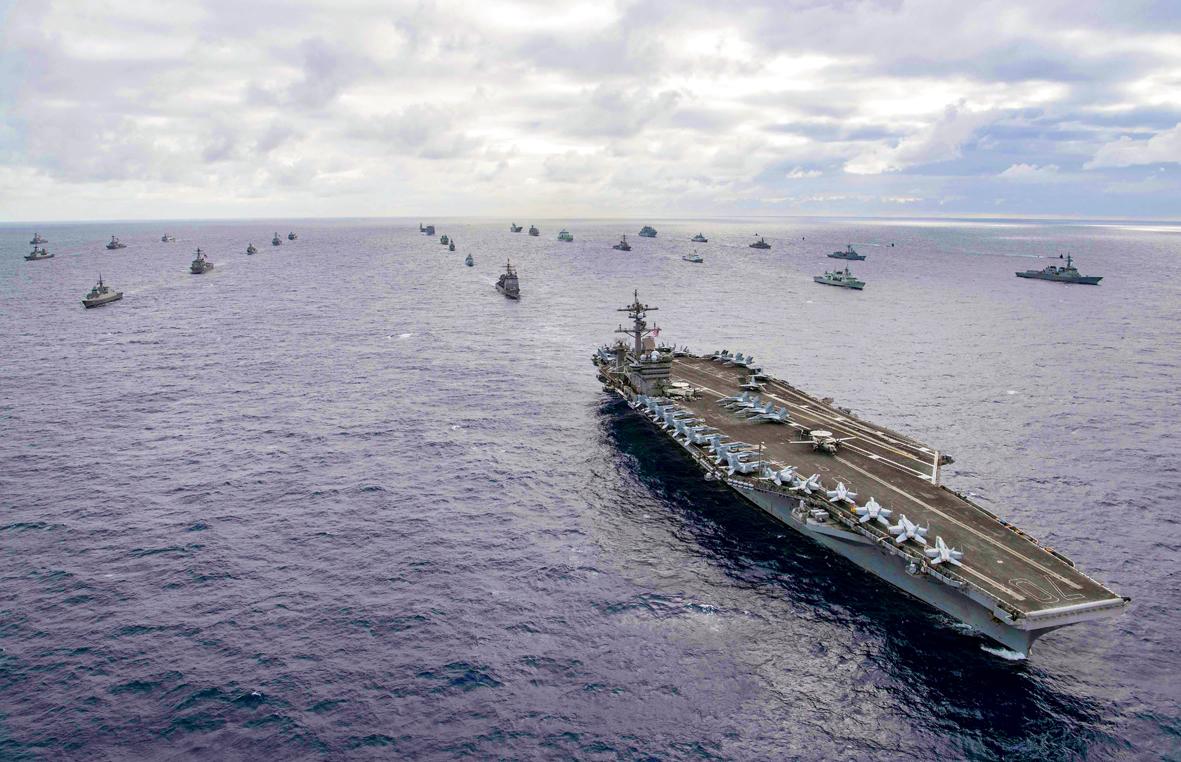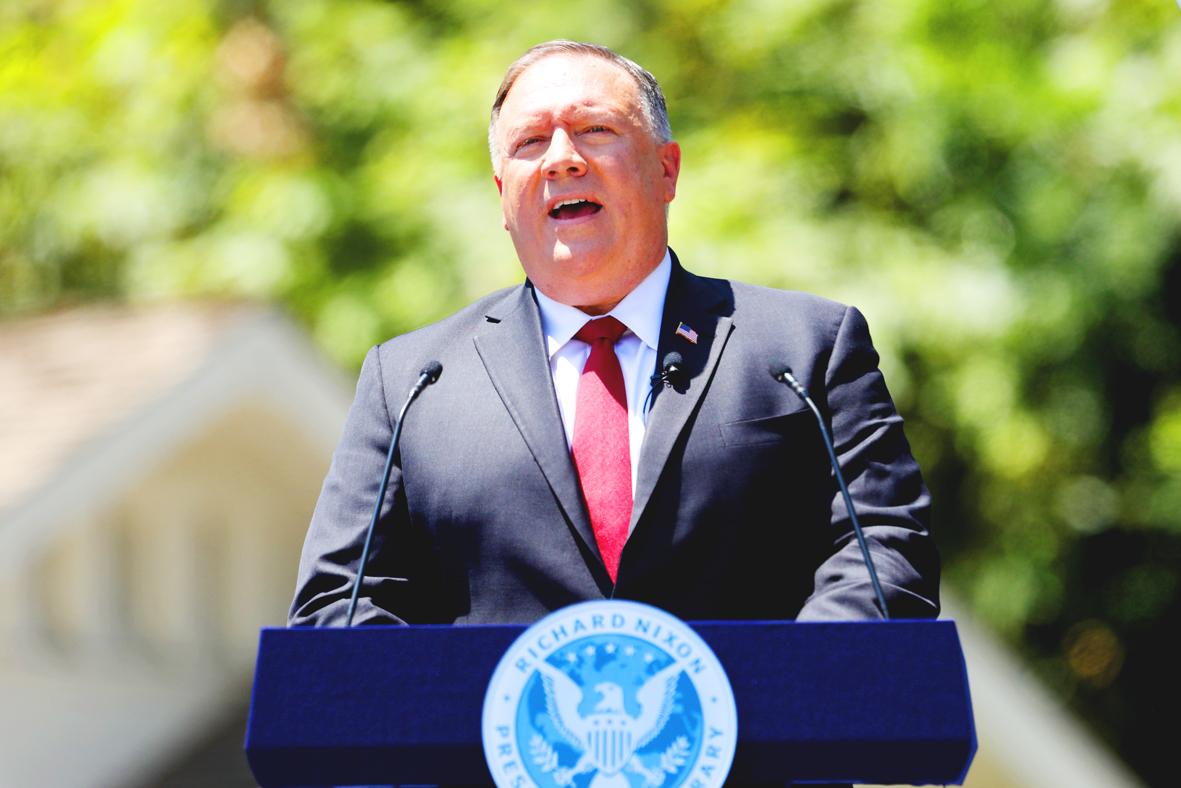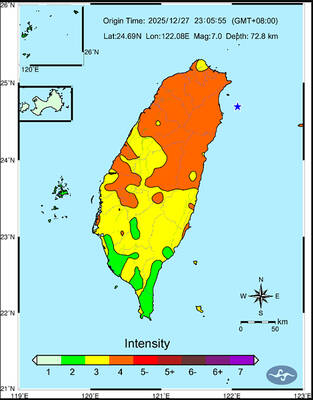The US Senate on Thursday passed its version of the US National Defense Authorization Act (NDAA) for next year, including provisions that support Taiwan’s participation in the Rim of the Pacific Exercise (RIMPAC), the world’s largest maritime warfare exercise, if appropriate.
The bill cleared the Senate floor in a 86-14 vote.
Provisions that include Taiwan are mentioned in sections 1258 and 1259 of the bill, which reiterates that the Taiwan Relations Act (TRA) and the “six assurances” provided by the US to Taiwan in July 1982 are “the foundation for United States-Taiwan relations.”

Photo: AFP / US NAVY / DYLAN M. KINEE
The “six assurances” were given by then-US president Ronald Reagan in 1982 and include pledges not to set a date for ending arms sales to Taiwan, not to hold prior consultations with China regarding arms sales to Taiwan, and not to be a mediator between Taiwan and China.
They also include assurances that the US will not revise the TRA or press Taiwan to enter into negotiations with China.
The NDAA also highlights US support for the development of Taiwan’s military, including through arms sales, exchanges between top defense officials and military exercises.

Photo: EPA-EFE
The exercises could include the RIMPAC, if appropriate, the NDAA says, although Taiwan has never participated before.
The NDAA also acknowledges China’s “increasingly coercive and aggressive behavior” toward Taiwan, contrary to the US’ expectation of a “peaceful resolution” of Taiwan’s future.
Citing the TRA, the NDAA says that the US would maintain the capacity “to resist any resort to force or other forms of coercion that would jeopardize the security, or the social or economic system, of the people on Taiwan, including the capacity of the United States armed forces to deny a ‘fait accompli’ operation by the People’s Republic of China to rapidly seize control of Taiwan.”
A section of the NDAA also advises the US Department of Defense to conduct port calls in Taiwan with two US naval hospital ships — the USNS Comfort and the USNS Mercy.
The port calls would allow “United States personnel to benefit from the expertise of Taiwanese personnel in light of the successful response of Taiwan to COVID-19” and would allow the two sides to continue collaborating on COVID-19 responses, the NDAA says.
The visits would also improve cooperation between the two sides in the areas of military medicine, humanitarian assistance and disaster relief, it said.
The US House of Representatives on July 21 passed its own version of the NDAA.
The two houses would soon begin negotiations to hammer out the differences in their competing bills before a final version can be signed into law by US President Donald Trump.
Separately on Thursday, US Secretary of State Mike Pompeo contrasted the responses of Taiwan and China to Washington’s policies.
“We opened our arms to Chinese citizens, only to see the Chinese Communist Party exploit our free and open society,” Pompeo said.
“We marginalized our friends in Taiwan, which later blossomed into a vigorous democracy,” he said.
Ministry of Foreign Affairs spokeswoman Joanne Ou (歐江安) yesterday thanked the US government for repeatedly voicing support for Taiwan publicly and urged other countries to face the threats posed by Beijing’s expansionism.
Whatever means China uses to squeeze Taiwan’s space in the global community, the government would never succumb to the pressure, Ou said in a statement, adding that the government would continue working with the US and other like-minded countries to defend democratic systems and a rule-based international order.
Ou also thanked the US Congress for continuing to promote Taiwan-US exchanges in military and security affairs.
The NDAA includes many provisions friendly to Taiwan, she said, adding that the ministry would monitor the bill’s development and maintain contact with US agencies to facilitate further Taiwan-US security cooperation.
Additional reporting by Lin Chia-nan

A magnitude 7.0 earthquake struck off Yilan at 11:05pm yesterday, the Central Weather Administration (CWA) said. The epicenter was located at sea, about 32.3km east of Yilan County Hall, at a depth of 72.8km, CWA data showed There were no immediate reports of damage. The intensity of the quake, which gauges the actual effect of a seismic event, measured 4 in Yilan County area on Taiwan’s seven-tier intensity scale, the data showed. It measured 4 in other parts of eastern, northern and central Taiwan as well as Tainan, and 3 in Kaohsiung and Pingtung County, and 2 in Lienchiang and Penghu counties and 1

FOREIGN INTERFERENCE: Beijing would likely intensify public opinion warfare in next year’s local elections to prevent Lai from getting re-elected, the ‘Yomiuri Shimbun’ said Internal documents from a Chinese artificial intelligence (AI) company indicated that China has been using the technology to intervene in foreign elections, including propaganda targeting Taiwan’s local elections next year and presidential elections in 2028, a Japanese newspaper reported yesterday. The Institute of National Security of Vanderbilt University obtained nearly 400 pages of documents from GoLaxy, a company with ties to the Chinese government, and found evidence that it had apparently deployed sophisticated, AI-driven propaganda campaigns in Hong Kong and Taiwan to shape public opinion, the Yomiuri Shimbun reported. GoLaxy provides insights, situation analysis and public opinion-shaping technology by conducting network surveillance

‘POLITICAL GAME’: DPP lawmakers said the motion would not meet the legislative threshold needed, and accused the KMT and the TPP of trivializing the Constitution The Legislative Yuan yesterday approved a motion to initiate impeachment proceedings against President William Lai (賴清德), saying he had undermined Taiwan’s constitutional order and democracy. The motion was approved 61-50 by lawmakers from the main opposition Chinese Nationalist Party (KMT) and the smaller Taiwan People’s Party (TPP), who together hold a legislative majority. Under the motion, a roll call vote for impeachment would be held on May 19 next year, after various hearings are held and Lai is given the chance to defend himself. The move came after Lai on Monday last week did not promulgate an amendment passed by the legislature that

AFTERMATH: The Taipei City Government said it received 39 minor incident reports including gas leaks, water leaks and outages, and a damaged traffic signal A magnitude 7.0 earthquake struck off Taiwan’s northeastern coast late on Saturday, producing only two major aftershocks as of yesterday noon, the Central Weather Administration (CWA) said. The limited aftershocks contrast with last year’s major earthquake in Hualien County, as Saturday’s earthquake occurred at a greater depth in a subduction zone. Saturday’s earthquake struck at 11:05pm, with its hypocenter about 32.3km east of Yilan County Hall, at a depth of 72.8km. Shaking was felt in 17 administrative regions north of Tainan and in eastern Taiwan, reaching intensity level 4 on Taiwan’s seven-tier seismic scale, the CWA said. In Hualien, the